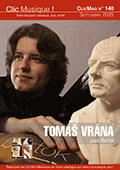 L'italien Lorenzo Perosi a consacré sa vie de compositeur à la musique religieuse. Élevé dans la religion et la musique, il obtient son premier poste d'organiste à dix-huit ans, étudie la polyphonie de la Renaissance en Bavière puis en France à l'abbaye de Solesmes. Revenu en Italie il s'établit à Rome où il se lie d'amitié avec le cardinal Sarto qui deviendra plus tard Pie X. Perosi devient alors Maître de Chapelle à Saint Marc. Fidèlement soutenu par Sarto il terminera sa carrière à la plus haute fonction : "Maestro Perpetuo" de la Chapelle Sixtine à Rome. Ensemble, ils publieront la fameuse encyclique Motu Proprio qui prône un retour à la musique ancienne, notamment au chant grégorien. Membre éminent de la "Giovane Scuolae" qui regroupait les compositeurs véristes, il est le seul qui n'ait pas écrit d'opéras. Son œuvre comprend plus logiquement des messes, de nombreux motets et plusieurs oratorios dont cette fresque liturgique en deux parties "La Transfigurazione e la Passione di Nostro Signore Gesù Cristo" transcrite ici pour orgue par l'organiste et compositeur Marco Enrico Bossi (1865-1921) grand apôtre lui aussi du mouvement cécilien. Précédé de quelques pièces d'orgue, l’œuvre montre avant tout la parfaite connaissance de Perosi et Bossi de la musique germanique (Bach en particulier) et de l'école d'orgue romantique. Quelques motifs de grégorien, quelques développements contrapuntiques traduisent cet attachement aux formes anciennes et classiques mais l'ensemble relève plutôt d'un type d'écriture semi-improvisée à vocation liturgique d'une pâleur d'expression et d'une austérité presque rebutante. Perosi & Bossi neutralisent ainsi tout affect ou contraste dramatique délavant une fresque alla Maurice Denis de toute couleur. L'orgue (un Mascioni construit en 1966) et l'organiste (Diego Cannizzaro) sont quant à eux aux abonnés absents. (Jérôme Angouillant)  Perosi’s organ compositions belongs to the youth period during the last decade of the XIX century. At that time being an organ player was absolutely preparatory for everyone who wanted to master and study the sacred music liturgy: the organ composition, sometimes even just musical miniatures, was therefore perfect for didactic use and, at the same time, to the liturgy. In Montecassino Abbey, from November 1890 to July 1891, he was theory and solfeggio teacher and organ player. Then he studied at the Conservatoire of Milan and in 1893 he finished the six-month course at Kirchenmusikschule in Regensburg, directed by Franz Xaver Haberl, who, noticed his musical value, tried to have him as organ professor. His organ competence was used for organ tests, inaugural concerts and was confirmed in 1894 by the invitation to become organ player in Parma. Among the lines emerges the discomfort for a reality that accompany him most of all during his training years: a music reality that spoke in a theatrical language, even in sacred music. For several decades organ literature had lived on this dependence and the turning point, attested by the rejection of theatrical modules, from the yearning of new organ composition and from the search for new compositional styles, coincides with the period of musical growth of the young Perosi, who, since the first compositional trials, adopted European modules. The organ pieces, some ordered in collections (20 orgel trio, Centonum), others in their own right, are presented with the obliged pedal: the author evidently turned his gaze elsewhere, perhaps mindful of the musical experiences of Regensburg where there were German-made organs with multiple keyboards and extended pedals. In these compositions, often very brief and evidently intended for liturgical use, multiple aspects are identified: the intimate picture, the elaboration of a Gregorian theme, the improvisational gash, the contrapuntal faded development and the recovery of classical structures. A constant restlessness animates these pages and the yearning for a renewal of one’s musical idiom is obvious. On 8 June 1894 he was given the job of choirmaster in the Basilica of S. Marco in Venice, on 15 December 1898 he was appointed by perpetual deputy director of the Pontifical musical chapel ‘Sistine’ by Leone XIII and on 1 January 1902 he will become the unique director. The position of kappelmeister will definitively divert Lorenzo Perosi from the composition of organ music, but his propensity for organ improvisation will never fail. The songs presented in this double CD come from three source. Marco Enrico Bossi, linked to Perosi by a profound personal friendship, created in 1899 transcriptions of large portions of Passione secondo S. Marco per soli, coro e orchestra, and of the oratory La Trasfigurazione di N. S.Gesù Cristo per soli, coro, organo e orchestra. Bossi does not fully transcribe the works, but only the following numbers: La Passione di Cristo secondo S. Marco. The organ expertise by Marco Enrico Bossi makes the transcriptions particularly effective for listening, while remaining very to the Perosian text. In them the great knowledge that Perosi and Bossi had of both the music of J. S. Bach and of the late romantic writing for the organ of the German school is very evident. The treatment of the various Canti firmi is fluent and is inserted into the harmonic tissue with remarkable spontaneity. The choice of numbers made by Bossi also gives the transcriptions a formal balance that makes them very pleasant for concert viewing.
 |
